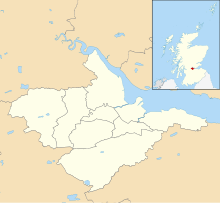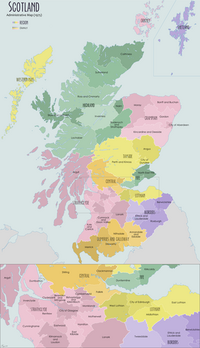Falkirk (council area)
Falkirk
| |
|---|---|
 Falkirk shown within Scotland | |
| Coordinates: 55°58′34″N 3°47′49″W / 55.976°N 3.797°W | |
| Sovereign state | United Kingdom |
| Country | Scotland |
| Lieutenancy area | Stirling and Falkirk |
| Unitary authority | 1 April 1996 |
| Government | |
| • Type | Council |
| • Body | Falkirk Council |
| • Control | No overall control |
| • MPs | 3 MPs |
| • MSPs | 2 MSPs |
| Area | |
• Total | 115 sq mi (297 km2) |
| • Rank | 22nd |
| Population (2022)[2] | |
• Total | 158,450 |
| • Rank | 11th |
| • Density | 1,380/sq mi (533/km2) |
| Time zone | UTC+0 (GMT) |
| • Summer (DST) | UTC+1 (BST) |
| ISO 3166 code | GB-FAL |
| GSS code | S12000014 |
| Website | falkirk |
Falkirk (/ˈfɔːlkɜːrk/ FAWL-kurk; Scots: Fawkirk [ˈfɔːkɪrk]; Scottish Gaelic: An Eaglais Bhreac) is one of 32 unitary authority council areas of Scotland. It was formed on 1 April 1996 by way of the Local Government etc. (Scotland) Act 1994 from the exact boundaries of Falkirk District, one of three parts of the Central region created in 1975, which was abolished at that time. Prior to the 1975 reorganisation, the majority of the council area was part of the historic county of Stirlingshire, and a small part, namely Bo'ness and Blackness, was part of the former county of West Lothian.
The council area borders with North Lanarkshire, Stirling and West Lothian, and, across the Firth of Forth to the northeast, Clackmannanshire and Fife. The largest town is Falkirk; other settlements, most of which surround Falkirk within 6 miles (9.7 km) of its centre, include Bo'ness, Bonnybridge, Denny, Grangemouth, Larbert, Polmont, Shieldhill, Camelon and Stenhousemuir.
The council is led by the SNP which won 12 seats in the 2022 Council Election. The incumbent leader of is councillor Cecil Meiklejohn; the provost is Robert Bissett and the deputy provost is David Balfour.
History
[edit]The town of Falkirk was made a burgh in 1600, and was then governed by a town council (also known as the corporation) until 1975.[3] Scotland's counties, burghs and landward districts were abolished in 1975 under the Local Government (Scotland) Act 1973, and replaced with upper-tier regions and lower-tier districts. A new Falkirk District was created as one of three districts within the Central Region. The new district was significantly larger than the old Falkirk burgh, covering the whole area of eight former districts and part of a ninth, which were all abolished at the same time:[4]
From Stirlingshire:
- Central No. 2 District, excluding most of Kilsyth parish
- Denny and Dunipace Burgh
- Eastern No. 1 District
- Eastern No. 2 District
- Eastern No. 3 District
- Falkirk Burgh
- Grangemouth Burgh
From West Lothian:
- Bo'ness Burgh
- Bo'ness District
The resulting area could also be defined in terms of parishes as:[5][6]
- Airth
- Bo'ness and Carriden
- Denny
- Dunipace
- Falkirk
- Grangemouth
- Kilsyth: Banknock polling district only
- Larbert
- Muiravonside
- Slamannan
The new district and its neighbour Stirling were together made a new Stirling and Falkirk lieutenancy area. The last Lord Lieutenant of Stirlingshire became the first Lord Lieutenant of Stirling and Falkirk.[7]
Local government was reformed again in 1996 under the Local Government etc. (Scotland) Act 1994, which abolished the regions and districts which had been created in 1975, replacing them with unitary council areas. Central Region was abolished and each of the area's three districts, including Falkirk, became council areas.[8]
Settlements
[edit]Largest settlements by population:
| Settlement | Population (2020)[9] |
|---|---|
| Falkirk |
35,590 |
| Grangemouth |
16,120 |
| Bo'ness |
14,840 |
| Larbert |
12,180 |
| Stenhousemuir |
9,620 |
| Denny |
8,500 |
| Bonnybridge |
5,200 |
| Polmont |
5,040 |
| Brightons |
4,270 |
| Maddiston |
3,910 |
Governance
[edit]Falkirk | |
|---|---|
 | |
| Leadership | |
Kenneth Lawrie since August 2018[12] | |
| Structure | |
| Seats | 30 councillors |
 | |
Political groups |
|
| Elections | |
| Single transferable vote | |
Last election | 5 May 2022 |
Next election | 6 May 2027 |
| Meeting place | |
| Falkirk | |
| Website | |
| www | |
Political control
[edit]The first election to Falkirk District Council was held in 1974, initially operating as a shadow authority alongside the outgoing authorities until the new system came into force on 16 May 1975. A shadow authority was again elected in 1995 ahead of the change to council areas which came into force on 1 April 1996. Political control since 1975 has been as follows:[13]
Falkirk District Council
| Party in control | Years | |
|---|---|---|
| No overall control | 1975–1977 | |
| SNP | 1977–1980 | |
| Labour | 1980–1992 | |
| No overall control | 1992–1996 | |
Falkirk Council
| Party in control | Years | |
|---|---|---|
| Labour | 1996–1999 | |
| No overall control | 1999– | |
Leadership
[edit]The leaders of the council since 2001 have been:[14]
| Councillor | Party | From | To | |
|---|---|---|---|---|
| David Alexander | SNP | Feb 2001 | May 2007 | |
| Linda Gow | Labour | 18 May 2007 | Jan 2010 | |
| Craig Martin | Labour | 28 Jan 2010 | 4 May 2017 | |
| Cecil Meiklejohn | SNP | 25 May 2017 | ||
Premises
[edit]From the district council's creation in 1975, it was based at the Municipal Buildings on West Bridge Street in Falkirk, which had been built for the former Falkirk Town Council and had been formally opened on 21 January 1966.[15] The building was part of a complex which also included a courthouse, a clinic, and an events venue and theatre called Falkirk Town Hall. Prior to 1966 the town council had been based at the old Municipal Buildings at 12–14 Newmarket Street in the town centre, which had been built in 1879.[16]
After deciding the 1966 building was uneconomic to repair and maintain, the council vacated the Municipal Buildings in 2020 pending their demolition.[17] The attached Falkirk Town Hall closed in 2023.[18] Since 2020, the council's offices have been distributed across several buildings throughout the area.[19][20] It was subsequently decided to build a new headquarters on the site of the former Callendar Square shopping centre in central Falkirk. Work began on the site in May 2024, and the new building is projected to be completed in 2027.[21]
Elections
[edit]Since 2007 elections have been held every five years under the single transferable vote system, introduced by the Local Governance (Scotland) Act 2004. Election results since 1995 have been as follows:[13]
| Year | Seats | SNP | Labour | Conservative | Independent / Other | Notes |
|---|---|---|---|---|---|---|
| 1995 | 36 | 8 | 23 | 2 | 3 | |
| 1999 | 32 | 9 | 15 | 2 | 6 | New ward boundaries.[22] |
| 2003 | 32 | 9 | 14 | 2 | 7 | |
| 2007 | 32 | 13 | 14 | 2 | 3 | New ward boundaries.[23] |
| 2012 | 32 | 13 | 14 | 2 | 3 | |
| 2017 | 30 | 12 | 9 | 7 | 2 | New ward boundaries.[24] |
| 2022 | 30 | 12 | 9 | 5 | 4 | |
Wards
[edit]
For the purposes of elections to Falkirk Council, the area is divided geographically into a number of wards which then elect either three or four councillors each by the Single Transferable Vote system. The electoral system of local councils in Scotland is governed by the Local Governance (Scotland) Act 2004, an Act of the Scottish Parliament which first introduced proportional representation to councils. These electoral wards are as follows:[24]
| Ward number |
Name | Location | Seats |
|---|---|---|---|
| 1 | Bo'ness and Blackness | 
|
3 |
| 2 | Grangemouth | 
|
3 |
| 3 | Denny and Banknock | 
|
4 |
| 4 | Carse, Kinnaird and Tryst | 
|
4 |
| 5 | Bonnybridge and Larbert | 
|
3 |
| 6 | Falkirk North | 
|
4 |
| 7 | Falkirk South | 
|
3 |
| 8 | Lower Braes | 
|
3 |
| 9 | Upper Braes | 
|
3 |
Communities
[edit]The area is divided into 23 community council areas, eleven of which have community councils as at 2023, being those with asterisks.[25]
- Airth Parish*
- Avonbridge and Standburn
- Banknock, Haggs and Longcroft*
- Blackness*
- Bonnybridge
- Bo'ness*
- Brightons*
- Camelon, Bantaskine and Tamfourhill*
- Carron and Carronshore
- Denny and District*
- Falkirk Central
- Falkirk South
- Grahamston, Middlefield and Westfield
- Grangemouth*
- Langlees, Bainsford and New Carron
- Larbert, Stenhousemuir and Torwood
- Lower Braes
- Maddiston
- Polmont*
- Reddingmuirhead and Wallacestone*
- Shieldhill and California
- Slamannan and Limerigg*
- Whitecross
References
[edit]- ^ "Council & democracy". Falkirk Council. Retrieved 7 September 2024.
- ^ a b "Mid-Year Population Estimates, UK, June 2022". Office for National Statistics. 26 March 2024. Retrieved 3 May 2024.
- ^ "Falkirk Burgh". A Vision of Britain through Time. GB Historical GIS / University of Portsmouth. Retrieved 2 March 2023.
- ^ "Local Government (Scotland) Act 1973", legislation.gov.uk, The National Archives, 1973 c. 65, retrieved 2 March 2023
- ^ "No. 16274". The Edinburgh Gazette. 19 October 1945. p. 357.
- ^ "No. 16269". The Edinburgh Gazette. 2 October 1945. p. 337.
- ^ "The Lord-Lieutenants Order 1975", legislation.gov.uk, The National Archives, SI 1975/428, retrieved 16 April 2023
- ^ "Local Government etc. (Scotland) Act 1994", legislation.gov.uk, The National Archives, 1994 c. 39, retrieved 2 March 2023
- ^ "Mid-2020 Population Estimates for Settlements and Localities in Scotland". National Records of Scotland. 31 March 2022. Retrieved 31 March 2022.
- ^ "Council minutes, 25 May 2022". Falkirk Council. Retrieved 2 March 2023.
- ^ "Council minutes, 24 May 2017". Falkirk Council. Retrieved 2 March 2023.
- ^ "New Chief Executive appointed". Falkirk Council. 19 April 2018. Retrieved 2 March 2023.
- ^ a b "Compositions calculator". The Elections Centre. 4 March 2016. Retrieved 3 March 2023.
- ^ "Council minutes". Falkirk Council. Retrieved 2 March 2023.
- ^ "Falkirk, West Bridge Street, Municipal Buildings". Canmore. Historic Environment Scotland. Retrieved 3 March 2023.
- ^ Historic Environment Scotland. "Social Work Department (former Municipal Buildings) Newmarket Street (Category C Listed Building) (LB31207)". Retrieved 3 March 2023.
- ^ "Common Good: Municipal Buildings". Falkirk Council. Retrieved 3 March 2023.
- ^ Paterson, Kirsty (24 February 2023). "Falkirk town hall set for demolition as councillors make final decision after consultation". Daily Record. Retrieved 3 March 2023.
- ^ "Offices and Municipal Buildings". Falkirk Council. Retrieved 3 March 2023.
- ^ Paterson, Kirsty (23 May 2023). "Falkirk Council: New town hall will be on Callendar Square site". Falkirk Herald. Retrieved 16 July 2023.
- ^ Paterson, Kirsty (25 April 2024). "Falkirk Town Hall: News welcomed of Callendar Square demolition to make way for new arts and civic building". Falkirk Herald. Retrieved 30 July 2024.
- ^ "The Falkirk (Electoral Arrangements) Order 1998", legislation.gov.uk, The National Archives, SI 1998/3254, retrieved 3 March 2023
- ^ Scottish Parliament. The Falkirk (Electoral Arrangements) Order 2006 as made, from legislation.gov.uk.
- ^ a b Scottish Parliament. The Falkirk (Electoral Arrangements) Order 2016 as made, from legislation.gov.uk.
- ^ "Executive report, 17 January 2023". Falkirk Council. Retrieved 3 March 2023.



